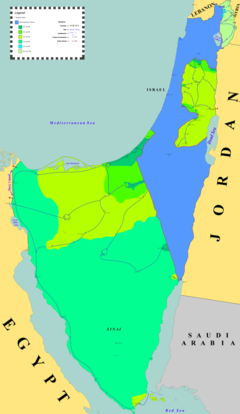UNITED STATES OF AMERICA AND LONDON HAVE EXERCISED THROUGH
MY CASE A FULL SCALE ATTACK ON INTERNATIONAL TREATIES/ UNITED NATIONS AND EXERCISED TOTAL DISDAIN FOR HUMAN LIVES/EXISTENCE.
Israeli occupation of the Sinai Peninsula
| Part of the Arab–Israeli conflict | |
 Territories occupied by Israel during the Six-Day War, 1967 | |
| Date | 29 October 1956 – 7 March 1957 (first occupation) 5 June 1967 – 25 April 1982 (second occupation)(Israel withdrew from Taba in March 1989) |
|---|---|
| Location | Sinai Peninsula, Egypt |
| Motive | Thwarting the Egyptian blockade of Israel (1949–1967) |
| Outcome | Egypt–Israel peace treaty (1979) |
| Verdict | March 1979: Egyptian recognition of Israel's sovereignty, termination of the blockade, and demilitarization along Israel's border April 1982: Israeli withdrawal from the Sinai Peninsula |
The Sinai Peninsula, which is a part of Egypt, has been militarily occupied by Israel twice: the first occupation lasted from October 1956 to March 1957, and the second occupation lasted from June 1967 to April 1982. Israel initially seized the Sinai Peninsula during the Suez Crisis, when it attacked Egypt in response to the Egyptian blockade against all Israeli shipping; the Egyptians had been contesting Israel's freedom of navigation through the Straits of Tiran and the Suez Canal since 1949, impacting the country's ability to import and export goods during the Israeli austerity period. Although the occupation allowed Israel to re-open the Straits of Tiran, the Suez Canal was closed until 1957, when Israeli troops withdrew from Egypt. In the mid-1960s, amidst warnings from Israeli officials that another blockade would be a casus belli, Egypt re-imposed the blockade against Israel and subsequently lost the Sinai Peninsula in the 1967 Arab–Israeli War. Like before, Israel's occupation allowed it to re-open the Straits of Tiran, but, once again, the Suez Canal was closed until 1975. For the next three years, Egypt, seeking to regain the territory it had lost, launched the unsuccessful War of Attrition against Israel. Later, a large-scale Egyptian military offensive against Israel, known as Operation Badr, triggered the 1973 Arab–Israeli War, which ended with the Israelis retaining control of the Sinai Peninsula. By 1979, the United States had successfully negotiated the Egypt–Israel peace treaty: the Egyptians recognized Israel as a sovereign state, recognized the Straits of Tiran and the Gulf of Aqaba as international waterways, and agreed to demilitarize along Israel's border. In exchange, Israel agreed to withdraw all civilians and soldiers from the Sinai Peninsula and return it to Egypt. On 25 April 1982, Israel's withdrawal concluded and Egypt has since left the Sinai Peninsula demilitarized, marking the first instance of peace between Israel and an Arab country.[1]
Between 1967 and 1982, a total of 18 Israeli settlements were constructed throughout the Sinai Peninsula, primarily along the Gulf of Aqaba and in the areas to the south of the formerly Egyptian-occupied Gaza Strip. Additionally, Israel dismantled two bases of the Israeli Air Force, one base of the Israeli Navy, and a number of other government/military installations, including most Israeli-controlled oil resources.
Background
Israeli forces first seized the Egyptian Sinai Peninsula during the Suez Crisis of October–November 1956. Under heavy international pressure, Israeli forces withdrew in March 1957, after heavily mapping the territory and placing secret supply caches in preparation for the next war. As part of the conditions for the Israeli withdrawal, the Sinai Peninsula was demilitarized and the UNEF peacekeeping force was established there to police the border between Israel and Egypt. In May 1967, Egyptian President Gamal Abdel Nasser ordered the withdrawal of this force and moved Egypt's own troops into the area. Israel, believing war to be imminent, ultimately launched a preemptive strike against Egypt, beginning the Six-Day War. Within three days, Israel had occupied most of the Sinai Peninsula.
Following the Israeli capture and occupation of the Sinai Peninsula, Egypt launched the War of Attrition (1967–1970) aimed at forcing Israel to withdraw from the Sinai Peninsula. The war saw protracted conflict in the Suez Canal Zone, ranging from limited to large scale combat. Israeli shelling of the cities of Port Said, Ismailia, and Suez on the west bank of the canal, led to high civilian casualties (including the virtual destruction of Suez), and contributed to the flight of 700,000[2] Egyptian internal refugees. Ultimately, the war concluded in 1970 with no change in the front line.[3] On 6 October 1973, Egypt commenced Operation Badr to retake the Sinai Peninsula, while Syria launched a simultaneous operation to retake the Golan Heights, thereby beginning the Yom Kippur War (known in Egypt and much of Europe as the October War). The canal was reopened in 1975, with President Sadat leading the first convoy through the canal aboard an Egyptian destroyer. In 1979, Egypt and Israel signed a peace treaty in which Israel agreed to withdraw from the entirety of the Sinai Peninsula. Israel subsequently withdrew in several stages, ending on 26 April 1982.[4]
Israeli settlements

Israeli settlements in the Sinai Peninsula were split into two regions: one along the Mediterranean coast, and another along the Gulf of Aqaba.[5] Israel had plans to expand the settlement of Yamit into a city of up to 200,000 residents.[6] The actual population of Yamit never exceeded 3,000.[7] The settlements in the Yamit region were demolished by Israel prior to the withdrawal, but the settlements on the gulf: Ofira (Sharm el-Sheikh), Di Zahav (Dahab), and Neviot (Nuweiba) remained intact, and were further developed by Egypt after the withdrawal.




No comments:
Post a Comment